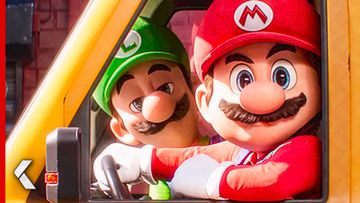Hilarious Easter Eggs in the Super Mario Bros. Movie
Did you spot these details in the Mario movie?
The new "Super Mario Bros. Movie" was only recently released in movie theaters, and it's already clear that it's well on its way to becoming one of the most successful animated movies ever. Over the extended Easter weekend, the movie grossed an impressive 377 million US dollars at the worldwide box office - the most successful start of a video game adaptation to date. In keeping with the Easter release, we would like to take a closer look at the many Easter Eggs which can be found hidden in the film. Given the quantity, it's unlikely that you'll be able to discover them all the first time you watch it. And obviously, there's a risk of spoilers for those of you who haven't seen the movie yet. So beware!
The first few minutes alone are a true treasure trove of hidden details. The first one is a reference to the "Super Mario Bros. Super Show!" released in 1989, which is best known today for the famous Mario rap. Based on a beat inspired by the video game's sound effects, Mario and Luigi rap in a time when hip-hop was just becoming truly popular. For that time, it was very modern - in hindsight, however, the rap is probably more classified as cringe. Nevertheless, it's a funny reference in the new film, which is used right at the beginning to introduce the characters.
After that, you see Mario and Luigi in a pizza parlor called "Punch-Out Pizzeria", which is a reference to another famous video game of the 1980s, "Punch-Out!". Fittingly, as the camera zooms out, you can also see many fighters from the original games hanging on the wall in the background. Likewise in the pizzeria, you can see Giuseppe playing an arcade game called "Jumpman". This is an Easter Egg in several ways: for one thing, Giuseppe is dubbed by Charles Martinet, who became world famous as a video game voice actor and as Mario's voice. For another, the game looks suspiciously like the very first "Donkey Kong" game from 1981. Jumpman was also the original name for Mario, who did make his first appearance in "Donkey Kong". So basically, they've included three Easter Eggs in one short scene here.
In general, there is a lot of meta-humor about Mario's video game history. For example, not only does the film show the games that made the Italian plumber world-famous, but he also plays the game "Kid Icarus" himself on an original NES console in his home. On the TV, you can also see an Arwing statue from the "Star Fox" game series, which was also developed by Nintendo.
Another Easter Egg that probably only fans of the N64 games have recognized is the design of Peach's castle. This is clearly based on the original "Super Mario 64" game and was basically only adjusted to the movie's visuals.
Luigi has plenty of Easter Eggs, too: In one scene during his captivity in Bowser's castle, he is seen handling a flashlight with flickering lights. This is reminiscent of his own game series "Luigi's Mansion", where the exact same thing takes place.
Of course, there are numerous allusions to Bowser as well. The piano he plays on, for example, was built by Ludwig von Koopa, as the inscription shows. This refers to the eldest of the Koopalings, Bowser's famous accomplices from the games, who are often bosses there. Ludwig seems to have a thriving piano business, so that's a welcome change here. He also makes a very brief appearance alongside Iggy and Lemmy as a member of a punk band that performs for Bowser.
